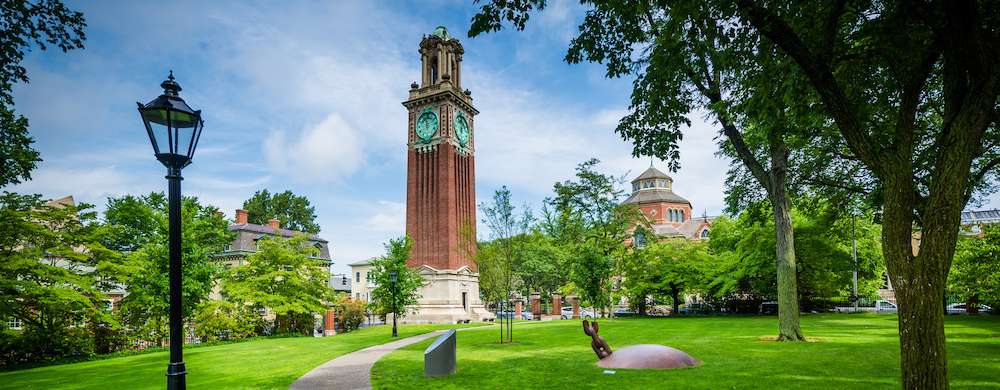As a leading research university and a member of the Ivy League, Brown University is a popular choice for many students. This institution, located in the heart of Providence, Rhode Island, has many top-tier programs in addition to a dual–degree program with neighboring Rhode Island School of Design. If Brown is on your list of top-choice schools, here’s what you need to know.
How to Get into Brown University: Table of Contents
- When to Apply to Brown University
- How Hard Is It to Get into Brown: Early Prep
- How Do You Actually Get into Brown: The Application
- Class Profile
- What Makes Brown University Unique?
- Brown University FAQs
When to Apply to Brown University
Like most U.S. institutions, Brown University utilizes a holistic admissions process that involves several steps and due dates. It’s important to submit all the required materials by the deadline, regardless of which admissions option you choose.
Brown Application Deadlines
Brown’s application deadlines may vary slightly from year to year, but generally occur around the same time during the academic calendar. For students applying during the 2024-2025 admissions cycle, the major application deadlines are as follows:
- November 1: Early Decision applications
- January 3: Regular Decision applications
Admissions decisions are released in mid-December for Early Decision applicants and by early April for Regular Decision applicants.
Early, Rolling, and Regular Decision
Students applying to multiple institutions may notice different application options, such as Early Action vs rolling admission. It’s important to be aware of the differences between these options so you can plan your application strategy.
Early Action and Early Decision both require you to submit your application early. Early Decision (ED) is binding — a student applying ED must commit to enrolling to that institution if they are admitted. By contrast, Early Action (EA) is not binding. Another EA admission type is Restrictive Early Action, which stipulates that students cannot apply to any other private college through an early admissions program. Early Decision is the only early admissions option offered at Brown.
Rolling admissions does not follow a strict deadline and typically has as application window from September through May. Despite this flexibility, it is still best to submit your application as early as possible, since RA schools only accept students until they reach their enrollment capacity. Brown University does not offer rolling admissions.
The last and most common admissions option is Regular Decision (RD), which is non-binding. Students who apply RD and are admitted can choose to enroll or attend another school. Brown University offers Regular Decision.
Waitlisted Applications
Students who apply Regular Decision to Brown may receive one of three admissions decisions: admitted, denied, or waitlisted. Being waitlisted is not a rejection — it simply means that there was not enough space in the incoming class for all the qualified students who applied. You can choose to accept or decline your spot on the waitlist. Keep in mind that your chances of getting off the waitlist are slim at hyper-competitive universities like Brown, so you may wish to enroll at a different institution.
Deferrals
Students who apply Early Decision may be admitted, denied, or deferred. A deferral means that their application will be evaluated during the Regular Decision round. Many students want to know what to do if they have been deferred. Students deferred at Brown must have their counselor submit a mid-year transcript and mid-year report so the admissions committee can review their fall term grades. Brown also accepts a letter of continued interest.
How Hard Is It to Get into Brown: Early Prep
As one of the most prestigious institutions in the U.S., Brown University is highly selective with a low admissions rate.
- Class of 2025: 5.52%
- Class of 2026: 5.00%
- Class of 2027: 5.23%
- Class of 2028: 5.16%
You can increase your chances of admission by learning what Brown looks for in their students and then building your profile accordingly during high school.
Build Your Profile
As you might expect, your academic record carries the most weight in Brown University’s admissions process. Admissions officers are looking for highly intelligent students who have pursued their interests deeply throughout high school and have made an impact on their schools and communities. Your high school course selection should demonstrate that you are prepared for the rigors of undergraduate study, and your extracurricular activities should be meaningful and aligned with your passions.
Visit the Campus and a Class
If you’re eager to attend Brown University, visiting the campus is the best way to determine if it’s a good fit for you. You can register for a campus tour and information session. If you are not able to attend in person, Brown offers virtual programming to give you a taste of campus life.
Prospective students can observe a class during their campus visit. The admissions office provides a list of courses that span a range of disciplines, allowing prospective students to choose a class that is of interest to them.
Connect With a Student
You can connect with Brown student ambassadors through the admissions office. These students are available via email to share their knowledge about the university and insights on campus life.
Learn About Any Student Experiences
In addition to connecting with a student ambassador, you can also approach the student tour guide on your campus tour or talk to students before or after you observe a class. This is a great way to get multiple perspectives on the student experience at Brown.
How Do You Actually Get into Brown: The Application
While there is no guarantee of gaining admission to Brown, you can take steps to increase your chance of acceptance. It’s important to look at the class profile of recently admitted students so you can see if your GPA, test scores, and other factors match up.
GPA Requirements
Brown University doesn’t have a GPA requirement and does not report the high school GPA of enrolled students. However, 95% of students in the class of 2027 graduated in the top 10% of their high school class. This indicates that you’ll need the highest possible GPA to gain admission.
SAT and ACT Scores
After being test-optional for several admissions cycles following the pandemic, Brown University now requires applicants to submit standardized test scores. To determine your goal score, it helps to look at the reported test scores of the most recently enrolled class. For the class of 2027, the middle 50 percent scored 1510–1560 on the SAT and 34–35 on the ACT. To do well on the SAT or ACT, start test prep well ahead of your testing date through self-study, tutoring, and practice exams.
Personal Statement
The personal statement is an opportunity to give the admissions committee insight into who you are and how you think about the world. You can choose one of the seven Common App essay prompts — this will be one of the longer essays you will write. Your personal statement is one of the best “soft factors” of your application, so it’s worth taking your time to write a thoughtful and authentic response.
Essays
In addition to your personal statement, you will be required to write the Brown supplemental essays. For the 2024-25 admissions cycle, Brown released these prompts.
Three essays are required for all first-year and transfer applicants:
1. Brown’s Open Curriculum allows students to explore broadly while also diving deeply into their academic pursuits. Tell us about any academic interests that excite you, and how you might pursue them at Brown. (200-250 words)
2. Students entering Brown often find that making their home on College Hill naturally invites reflection on where they came from. Share how an aspect of your growing up has inspired or challenged you, and what unique contributions this might allow you to make to the Brown community. (200-250 words)
3. Brown students care deeply about their work and the world around them. Students find contentment, satisfaction, and meaning in daily interactions and major discoveries. Whether big or small, mundane or spectacular, tell us about something that brings you joy. (200-250 words)
First-year applicants are also asked to reflect briefly on each of the very short answer questions below. We expect that answers will range from a few words to a few sentences at most.
- What three words best describe you? (3 words)
- What is your most meaningful extracurricular commitment, and what would you like us to know about it? (100 words)
- If you could teach a class on any one thing, whether academic or otherwise, what would it be? (100 words)
- In one sentence, Why Brown? (50 words)
Two essays are required for applicants to the PLME in addition to the three essays required of all first-year applicants:
1. Committing to a future career as a physician while in high school requires careful consideration and self-reflection. Explain your personal motivation to pursue a career in medicine, and why the Program in Liberal Medical Education (PLME) will best meet your professional and personal goals. (500 words)
2. Healthcare is constantly changing as it is affected by racial and social inequities, economics, politics, technology, and more. Please respond to one of the following prompts (250 words):
- How will you, as a future physician, make a positive impact?
- How has your personal background uniquely shaped your perspective on the field of medicine?
One essay is required for applicants to the Brown|RISD Dual Degree Program in addition to the three essays required of all first-year applicants:
1. The Brown|RISD Dual Degree Program draws on the complementary strengths of Brown University and Rhode Island School of Design (RISD) to provide students with the opportunity to explore and engage with diverse spheres of academic and creative inquiry. The culmination of students’ five-year program is a capstone project that relates and integrates content, approaches, and methods from two distinct learning experiences. Considering your understanding of the academic programs at Brown and RISD, describe how and why the specific blend of RISD’s experimental, immersive combined studio and liberal arts program and Brown’s wide-ranging courses and curricula could constitute an optimal undergraduate education for you. Additionally, how might your academic, artistic and personal experiences contribute to the Dual Degree community and its commitment to interdisciplinary work? (650 word limit)
Letters of Recommendation
Brown University requests two letters of recommendation from teachers and one from your counselor. Request recommendation letters from teachers who have taught you in the core academic subjects, particularly in your area of interest, and know you well. Teachers and counselors often receive multiple requests for recommendations, so try to ask by the end of your junior year to give them plenty of time.
Admission Interviews
In years past, students had the option to interview with Brown alumni. However, Brown no longer offers interviews. Instead, students are encouraged to submit a two-minute video introduction to the Brown admissions office to share more about themselves beyond what’s in their application.
Contribution to the Brown Community
Brown University admissions officers are eager to admit applicants who will make a lasting impact on the Brown community. Throughout every component of the application process, highlight your goals and the role you would take on once enrolled. Use specific details, including clubs, courses, and research opportunities that interest you.
Class Profile
Brown not only has a low acceptance rate, but its class sizes are also small. Here are a few admissions outcomes for the class of 2027:
What Makes Brown University Unique?
Perhaps the most unique aspect of Brown University is its Open Curriculum, which allows you to develop a personalized course of study. As opposed to many other colleges, Brown does not have a set of core courses or course requirements that all students must complete. Instead, their Open Curriculum provides greater freedom for you to study what interests you while continuing to explore other subjects.
Students have more than 500 clubs and organizations to choose from that span a diverse array of interests. That said, more than half of Brown’s undergraduates choose the arts as a co-curricular interest, making performing arts groups a popular activity on campus. Brown also has many athletic offerings, including 37 intramural and 34 varsity sports teams.
The university also hosts some must-see destinations. Brown is home to the John D. Rockefeller Library — known as “the Rock” — as well as the John Carter Brown Library, an independent center for advanced research in history and the humanities. Students are close to the RISD Museum in Providence, which houses an impressive collection of art and design from around the world. It’s one of the largest university art collections in the country.
Additionally, many notable alumni from Brown have made their mark in politics, business, the media, and the arts.
Brown FAQs
Where is Brown University located?
Brown University is located in Providence, Rhode Island.
What is Brown University known for?
Aside from being an Ivy League school, Brown is known for its Open Curriculum, which gives students the flexibility to pursue a personalized course of study without having to fulfill core curriculum requirements.
What is the acceptance rate for Brown University?
During the past four admissions cycles, Brown University’s acceptance rate has been around 5%, making it an extremely competitive school for admission.
What does Brown University look for in students?
Brown not only seeks students who are high achievers academically, they also look for students who dive deep into their interests and have contributed to their schools and communities.
How many students attend Brown University?
The student population at Brown University is approximately 10,700 students total — about 7,200 of whom are undergrads.
Admission Counseling
Students interested in gaining admission to highly selective universities like Brown can benefit from college admissions counseling. An experienced college admissions counselor can guide students through every stage of the college admissions process, from early college prep to finalizing and submitting their applications. Do plenty of research so you can pick an admissions counselor who brings out the best in you.
IvyWise admission experts have helped thousands of students gain admission to their top-choice schools, including Brown University. If Brown is one of your dream schools, schedule an Initial Consultation today to learn how we can help give you the best chance of admission.
Get Started




